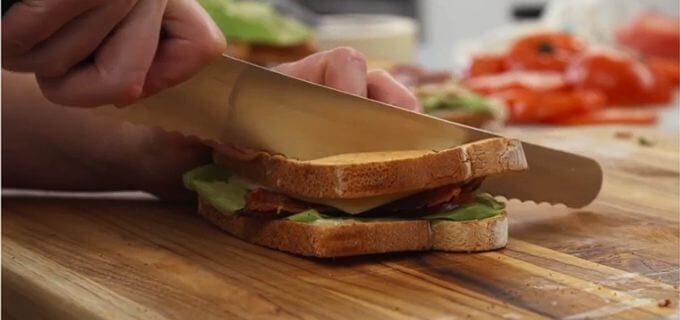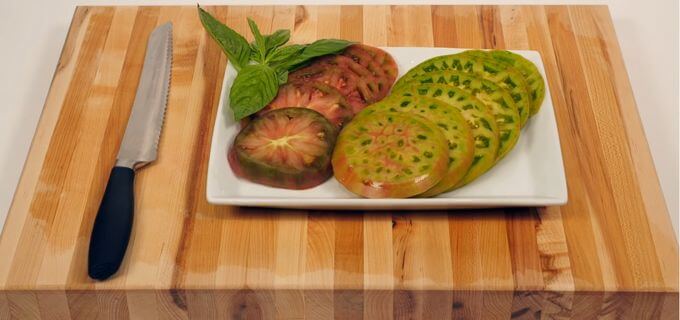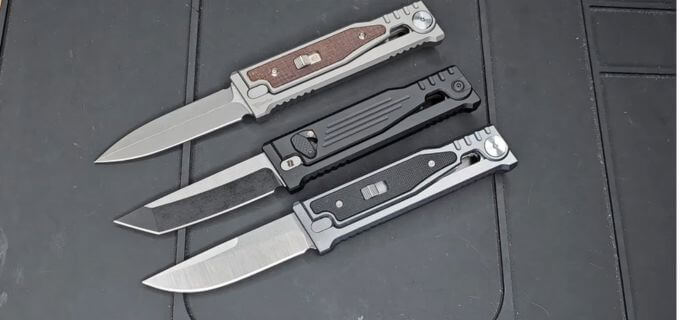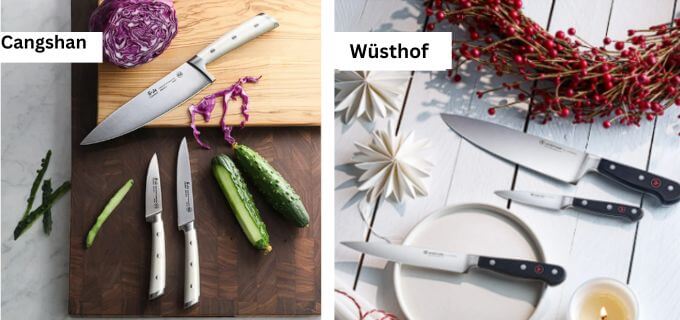If you’ve ever tried to slice a ripe tomato with a regular chef’s knife, you’ve probably realized how tricky it can be to cut through that smooth, delicate skin without squishing the juicy insides. That’s where the serrated knife comes into play. Whether you’re an experienced chef or just enjoy dabbling in the kitchen, the serrated knife is an absolute must-have tool.
It may look like a bread knife with its saw-like edges, but the serrated knife does so much more than slice bread. It’s a versatile, often underestimated tool that tackles tasks a standard chef’s knife might struggle with. Today, let’s dive deep into understanding the serrated knife, why it’s unique, and how it can elevate your kitchen skills.
Understanding the Serrated Edge
The serrated edge has a series of small, pointed “teeth” along the cutting edge, unlike a smooth chef’s knife. These tiny teeth grip the surface of the food and allow you to slice through it with less pressure.
This makes it ideal for foods that have a tough exterior but a soft interior. Serrated knives usually come in various lengths, with some as small as a paring knife and others long enough to slice through an entire loaf of bread in one go.
They don’t require the same sharpening frequency as straight-edged knives because the unique edge allows them to stay sharper longer.
However, when they do need sharpening, the process is slightly different and often requires special tools.
The Best Tasks for a Serrated Knife
So, what exactly is a serrated knife used for? Let’s break down the best uses:
Bread and Baked Goods
First and foremost, a serrated knife is a baker’s best friend. It’s no coincidence that many people refer to serrated knives as “bread knives.” The teeth allow you to cut through crusty bread without crushing the soft, airy inside.
The same goes for pastries, cakes, and other baked treats. If you’ve ever struggled with cutting a slice of cake without smushing the frosting, a serrated knife is a perfect solution. It lets you make clean, gentle cuts with minimal pressure, preserving the structure and appearance of your baked goods.
Tomatoes and Delicate Fruits
There’s a reason why chefs often keep a serrated knife handy for tomatoes. The serrated edge easily breaks the skin without pressing down on the flesh, ensuring a smooth cut every time. The same goes for other fruits like peaches, plums, or even grapes.
These fruits have tender insides and a slick skin that’s tough to cut without crushing. With a serrated knife, you can slice through these fruits effortlessly, keeping all the juices and textures intact.
Citrus Fruits
Lemons, limes, and oranges can be tough to cut with a standard chef’s knife, especially if the skin is thick. A serrated knife makes it easier to break through the outer peel and segment the fruit without mushing it up.
The saw-like edge digs into the peel, so you can get those perfect citrus wedges or rounds for garnishing drinks or adding a burst of flavor to your dishes.
Sandwiches and Delicate Pastries

When you want to cut a delicate sandwich without squishing the ingredients or tearing the bread, a serrated knife works wonders. It allows you to saw through each layer cleanly, even if the sandwich has thick bread, tomatoes, lettuce, or any other challenging ingredients. The same is true for delicate pastries, where you don’t want to press too hard and risk deforming the flaky, airy layers.
Meat with a Crust or Skin
Have you ever tried cutting through a piece of roasted meat with crispy skin? A serrated knife can be incredibly helpful in this scenario. The teeth grip the crust or skin, allowing you to slice through without tearing the meat inside. It’s especially useful for dishes like roast chicken, pork belly, or any meat with a flavorful, caramelized crust.
Why Serrated Knives Stay Sharp Longer
One of the biggest perks of a serrated knife is its longevity. Unlike a chef’s knife that requires frequent honing, the design of a serrated blade allows it to stay sharp for longer periods. Each tiny “tooth” works independently, so when one area gets dull, the others continue to grip and slice effectively. Additionally, because you use a sawing motion with a serrated knife, there’s less pressure on any one point of the blade, which helps to preserve its sharpness.
That being said, when a serrated knife does eventually need sharpening, the process is more specialized. Since the edge isn’t a single, straight line, you can’t simply sharpen it on a regular honing steel. Instead, you’ll need a sharpening tool that can fit each “tooth” individually, or you may consider having it professionally sharpened.
Tips for Using and Caring for Your Serrated Knife
To get the most out of your serrated knife, it’s essential to use it correctly and care for it well. When using a serrated knife, always let the blade do the work. Instead of applying a lot of pressure, use a gentle sawing motion. This is particularly effective with bread and delicate fruits. If you find yourself pressing down hard, you might not be using the right type of knife for the job.
In terms of cleaning, hand-washing your serrated knife is ideal. Dishwashers can be harsh on blades, especially for serrated edges, which are more prone to getting nicked or damaged. Gently clean your knife with warm, soapy water and dry it immediately to prevent rust or discoloration. Storing it properly is also important; a knife block or magnetic strip can keep the edge from dulling prematurely.
Choosing the Right Serrated Knife for Your Kitchen
Not all serrated knives are the same, so it’s worth choosing one that fits your kitchen needs. The length of the blade can vary, and longer blades are typically more versatile, allowing you to tackle large items like loaves of bread or thick-skinned fruits with ease.
A comfortable handle is essential, too, especially for precision tasks. Some serrated knives are full tang, meaning the blade runs through the handle, offering better balance and durability.
Conclusion
A serrated knife might not be the flashiest tool in your kitchen, but it’s undoubtedly one of the most practical. From slicing bread and delicate fruits to handling crusty meats, this knife is a master of versatility. While it may not be a replacement for your chef’s knife, it’s a fantastic companion that can make your cooking experiences easier and more enjoyable. If you don’t already own one, consider adding a serrated knife to your collection; it’s an investment that will pay off with each clean, effortless cut.


